Abstract
Germinated grains are extensively used in weaning and geriatric foods. Germination generally improves the nutrient content and digestibility of foods. The present investigation examined the influence of germination of faba bean, soybean, rice, and wheat on the availability of iron, zinc, calcium, manganese, and copper. Germination increased the availability of iron by >fourfold from faba bean and soybean and by >twofold from rice, whereas such a beneficial influence was not seen in wheat. The availability of zinc from rice and wheat increased to an extent of 80% and 87%, respectively, as a result of germination. However, germination reduced the availability of zinc from faba bean and soybean. Germination increased the availability of calcium from faba bean, soybean, and rice. Germination did increase the availability of manganese from soybean (14.4%) and rice (43%), whereas germination did not exert any influence on availability of copper from rice and wheat; it significantly decreased (12.7% and 14.3%, respectively) the same from faba bean and soybean. Thus, germination could be an appropriate food-based strategy to gain iron and other minerals maximally from food grains.
Los granos germinados son muy utilizadas en alimentos de destete y geriátricos. La germinación generalmente mejora el contenido de nutrientes y la digestibilidad de los alimentos. La presente investigación examinó la influencia de la germinación de semillas de haba, soja, arroz y trigo sobre la disponibilidad de hierro, zinc, calcio, manganeso y cobre. La germinación aumentó la disponibilidad del hierro por más de 4 veces a partir de habas de soja y por más de 2 veces a partir de arroz, mientras que una influencia beneficiosa no se observó en trigo. La disponibilidad de zinc a partir de arroz y trigo aumentó en un grado de 80 y 87%, respectivamente, como resultado de la germinación. Sin embargo, la germinación redujo la disponibilidad de zinc a partir de habas y soja. La germinación aumentó la disponibilidad de calcio en habas, soja y arroz. La germinación hizo aumentar la disponibilidad de manganeso a partir de soja (14,4%) y arroz (43%). Mientras que la germinación no ejerció ninguna influencia sobre la disponibilidad de cobre del arroz y el trigo, que disminuyó significativamente (12,7% y 14,3%), lo mismo en habas y soja. Por lo tanto, la germinación puede ser un estrategia apropiado basada en el alimento para ganar hierro y otros minerales al máximo de granos alimenticios.
Palabras claves:
Introduction
Deficiencies of micronutrients, especially minerals such as iron, zinc, and calcium, are widespread in developing countries such as China, and this area is a cause for concern. Although many factors including inadequate dietary intake of these micronutrients are responsible for the onset of iron and zinc deficiencies, their poor bioavailability from plant foods is probably the most likely cause (Gibson, Citation1994; Sandberg, Citation2002). Therefore, evolving dietary strategies to maximize the bioavailability of these micronutrients is one of the ways in which this public health problem can be overcome. Food-processing methods such as heat treatment, germination, and fermentation have been evidenced to enhance the bioavailability of iron and zinc from cereals and legumes grains (Lestienne, Besanon, Caporiccio, Lullien-Pellerin, & Treche, Citation2005a; Lestienne, Icard-Verniere, Mouquet, Picq, & Treche, Citation2005; Liang, Han, Nout, & Hamer, Citation2008; Luo, Gu, Han, & Chen, Citation2009). Germination and fermentation of grains are generally practiced food-processing methods in China. Some of the cereals so processed also form foods for infants and older adults. Germination of pulses and cereals is one of the traditional methods of food processing, which is extensively used in the preparation of weaning and geriatric foods. Germination generally improves the nutritional quality of foods by increasing their nutrient content and digestibility. The content of vitamin C is particularly enhanced during the process of germination (Xu, Dong, & Zhu, Citation2005). Germination can bring about a twofold increase in bioavailability of iron, whereas malting of minor millets brings about a 5- to 10-fold increase in the same (Tontisirin, Nantel, & Bhattacharjee, Citation2002). Most weaning foods are prepared from cereals or starchy roots, commonly reconstituted with water. Such foods become highly viscous when reconstituted and are difficult to feed to infants. Due to the small stomach capacity of infants, they cannot consume adequate amounts of bulky foods, resulting in inadequate intakes of vital nutrients. Hence, it is important to increase the calorie density of such weaning foods to the extent possible. Germination is known to reduce the viscosity of foods through amylolytic breakdown of starch, thus reducing bulk. Such malted foods, when used in the preparation of weaning foods, have the advantage of increased calorie density as a result of reduced viscosity. Such low-viscosity foods would also find application in the preparation of geriatric foods. During the process of aging, there is a reduction in gastrointestinal motility, thus making it difficult for the elderly to digest foods. Thus, foods of low viscosity and easy digestibility are desirable for these age groups. Information on the effect of germination of food grains on mineral availability, however, is limited. In Latin American countries, household food-processing methods such as fermentation and germination are used in formulating infant foods (Devadas, Citation1998). In view of this, the present investigation was carried out to examine the influence of germination of faba bean, soybean, rice, and wheat on the availability of iron, zinc, calcium, manganese, and copper.
Materials and methods
Materials
Two legumes, faba bean (Viciafaba) and soybean (Glycinehispida), and two cereals, rice (Oryza sativa) and wheat (Triticumaestivum), were purchased locally, cleaned, and used. All other chemicals used here were of analytical grade. Triple-distilled water was employed during the entire study. Acid-washed glassware was used throughout the study.
Germination of food grains
Hundred gram portions of the faba bean, soybean, and wheat samples (taken in five replicates) were initially soaked for 24 h at room temperature; these grains were spread on a cloth and maintained moist by periodic sprinkling of water for 48 h. The sprouted grains were then sun-dried for 2 h, and the sprouts were removed physically by applying gentle pressure and sieving. The grains were then toasted in an open pan at around 80 ºC for 3–4 min until a pleasant aroma developed. The toasted grains were ground to a fine powder in a stainless steel blender. In the case of rice, after removal of the husk by using a rice hulling machine, the brown rice was germinated at 25ºC for 3 days and dried at 55ºC for 2 h. The rootlets were then removed physically, and the grains were tempered by adding 7% moisture and ground to a powder. The method adopted for germination was similar to that commonly practiced in Chinese households.
Determination of total mineral content
Iron, zinc, calcium, manganese, and copper content in grain samples were analysed by atomic absorption spectrophotometry (Varian Spectr AA 200, Victoria, Australia) after dry ashing for 2 h at 530°C. Depending on the different treatments, 2–4 g of ash was weighed in a silicon evaporating dish. Next, the ashes were wet-acid digested with nitric acid on a hot plate and solubilized with 25 ml of 0.5 N HCl.
Determination of minerals availability
Iron, zinc, calcium, manganese, and copper availability was defined as the relative amount of iron, zinc, calcium, manganese, and copper that becomes soluble after enzymatic treatment. Grain samples were sequentially digested with enzymes, including amylase, pepsin, pancreatin, and bile, under certain conditions following the enzymatic degradation procedure described by Kiers, Nout, and Rombouts (Citation2000). Mixtures were centrifuged at 5000g for 15 min at 4°C. The resulting supernatant was filtered (0.45 μm membrane, FP 030/3, Kaijie, Hangzhou, Zhejiang) and frozen until further analysis. Iron, zinc, calcium, manganese, and copper levels, including soluble free ionizable iron, zinc, calcium, manganese, and copper and soluble complexes of iron, zinc, calcium, manganese, and copper, were analysed by atomic absorption spectrophotometry. Each sample was enzymatically extracted in duplicate. Iron, zinc, calcium, manganese, and copper availability contents were determined on three independent digests.
Statistical analysis
Data were analysed with SPSS 15.0 for windows. The mean and standard deviation of means were calculated. The data were analysed by one-way analysis of variance (ANOVA). Duncan’s multiple range test was used to separate means. Significance was accepted at probability p < 0.05.
Results and discussion
The contents of iron, zinc, calcium, manganese, and copper in the raw and germinated cereal grains are presented in . All of the cereal grains examined had similar iron contents, ranging from 36.7mg/kg in rice to 21.2mg/kg in raw wheat. Wheat had the highest amount of zinc (32.8 mg/kg), whereas the zinc content of the other three grains ranged from 15.4 to 17.1 mg/kg. Faba bean and soybean had significantly high contents of calcium, being 1321 and 1396 mg/kg, respectively. Rice and wheat contained 374 and 402.1 mg of calcium/kg, respectively. Manganese content was highest in the soybean (69.8 mg/kg), whereas it ranged from 8.3 to 38.3 mg/kg in the other three grains. Copper content of the grains ranged from 2.5mg/kg in faba bean to 6.3 mg/kg in rice. Wheat had significantly higher copper content, being 7.8 mg/kg. As expected, germination of the grains did not influence their mineral content, except for bringing about a slight decrease in the copper content of rice.
Table 1. Iron, zinc, calcium, manganese, and copper contents of germinated cereals and legumes.
Tabla 1. Contenidos de hierro, zinc, calcio, manganeso y cobre de cereales y legumbres germinados.
The effect of germination on iron availability from faba bean, soybean, rice, and wheat is presented in . Germination brought about an enormous improvement in the availability of iron from faba bean, soybean, and rice. The extent of increase was nearly fourfold in faba bean and soybean and around twofold in the case of rice. Germination, however, did not bring about a similar enhancing effect on the availability of iron from wheat ().
Figure 1. Effect of germination of grains on the bioavailability of iron. Values are mean ± SD of five replicate determinations.
Figura 1. Efecto de la germinación de los granos sobre la biodisponibilidad de hierro. Los valores son la media ± SD de cinco determinaciones repetidas.
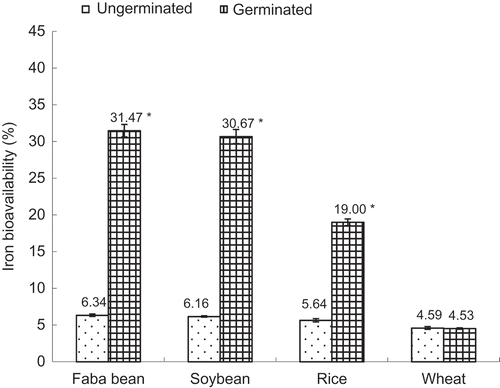
The availability of zinc from rice and wheat was enormously increased as a result of germination (). The increase was 80% and 87% in rice and wheat, respectively. Contrary to this, germination significantly decreased the availability of zinc from faba bean and soybean (), the percent decreases being 82% and 73% in faba bean and soybean, respectively.
Figure 2. Effect of germination of grains on the bioavailability of zinc. Values are mean ± SD of five replicate determinations.
Figura 2. Efecto de la germinación de los granos sobre la biodisponibilidad de zinc. Los valores son la media ± SD de cinco determinaciones repetidas.
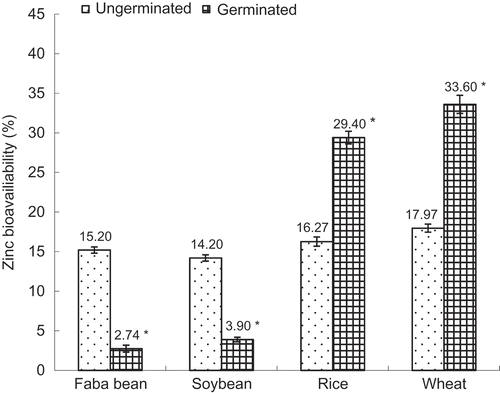
Germination brought about a slight increase in calcium availability from faba bean, soybean, and rice, the extent of increase being 18%, 10.1% and 28.5%, respectively (). Such a beneficial effect of germination on the availability of calcium was not evident in the case of wheat. Thus, the beneficial influence of germination on the availability of calcium was similar to that of iron, being restricted to faba bean, soybean, and rice.
Figure 3. Effect of germination of grains on the bioavailability of calcium. Values are mean ± SD of five replicate determinations.
Figura 3. Efecto de la germinación de los granos sobre la biodisponibilidad de calcio. Los valores son la media ± SD de cinco determinaciones repetidas.
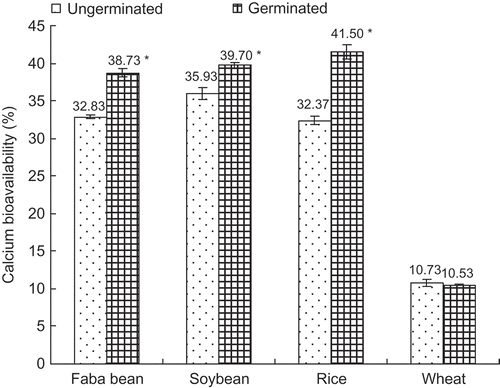
The availability of manganese from soybean and rice was significantly increased as a result of germination, the percent increase being 14.4% and 43% (). Germination had no effect on the availability of manganese from faba bean. Similar to that of iron and calcium, malting did not have a beneficial influence on manganese availability from wheat.
Figure 4. Effect of germination of grains on the bioavailability of manganese. Values are mean ± SD of five replicate determinations.
Figura 4. Efecto de la germinación de los granos sobre la biodisponibilidad de manganeso. Los valores son la media ± SD de cinco determinaciones repetidas.
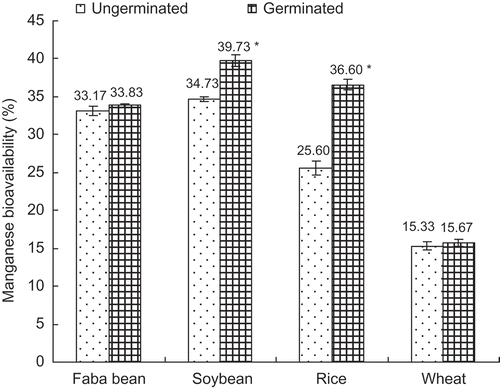
Although germination did not exert any influence on availability of copper from rice and wheat, it brought about a significant decrease in the same from faba bean and soybean ( ), the percent decrease in this case being 12.7% and 14.3%.
Figure 5. Effect of germination of grains on the bioavailability of copper. Values are mean ± SD of five replicate determinations.
Figura 5. Efecto de la germinación de los granos sobre la biodisponibilidad de cobre. Los valores son la media ± SD de cinco determinaciones repetidas.
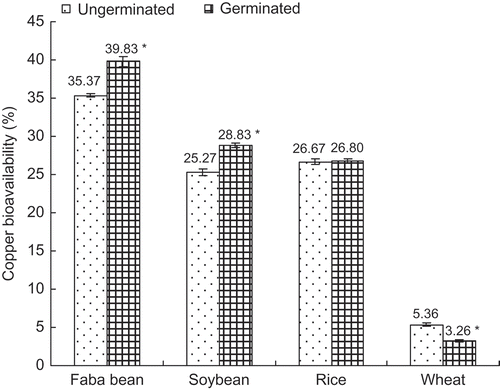
Thus, germination generally improved the availability of the minerals examined. This beneficial influence of germination was enormous in the case of iron availability from three of the four grains examined. On the other hand, although germination brought about a significant increase in zinc availability from rice and wheat, the same was significantly decreased in the faba bean and soybean. The conspicuous contrasting influence of germination on iron and zinc availability is evident only in the case of faba bean and soybean but not in rice and wheat. The reason for such differentiation of grains on the availability of these two minerals needs to be elucidated further. This study also suggests that germination of rice may form a good strategy to provide higher amounts of bioaccessible minerals, except copper.
Phytic acid is myo-inositol 1,2,3,4,5,6-hexakis dihydrogenphosphate and is considered as the primary storage form of phosphorus and inositol in legumes seeds (Luo, Xie, Xu, & Luo, Citation2012). Phytate, the complex of phytic acid and mineral elements, is especially known as a chelating agent that reduces the bioavailability of minerals. Phytases have been isolated and/or characterized in cereals and legumes. Phytase (myo-inositol hexakisphosphatephosphohydrolases) is a phytate-specific phosphatase that hydrolyses phytate to inositol and free orthophosphate and releases minerals. Food processes, including soaking, germination, and fermentation, seem to be relatively simple and nonchemical approaches for reducing phytate and improving the nutritional quality of legume (Luo, Xie, Jin, Wang, & Zai, Citation2013).These processes have demonstrated, under optimal conditions, their ability to reduce the phytate content of legume, accompanied by alarge increase in phytase activity. In ungerminated seeds, very little endogenous phytase activity is detectable, while, during germination, phytase activity increases and phytate levels decrease (Konietzny, Greiner, & Jany, Citation1995).
The beneficial effect of germination on iron and calcium availability, which was evident in faba bean (Luo et al., Citation2013), soybean, and rice, may probably be attributed to the decrease in phytate content as a result of germination. The phytate content was highest in faba bean and soybean (836 mg/100 g and 588 mg/100 g), followed by rice (417 mg/100 g) and wheat (278 mg/100 g) (Bartnik & Szafranska, Citation1987; Cheryan, Citation1980; Luo, Xie, Xie, Li, & Gu, Citation2009; Reddy, Sathe, & Salunkhe, Citation1982). Wheat, the intrinsic phytate content of which was relatively lower, did not find similar advantage of enhanced availability of these minerals as a result of germination. Among the inhibitors of mineral availability inherent in cereal grains and legumes, phytate has been observed to be dominant as compared to either dietary fibre or tannin (Ekholm, Virkki, Ylinen, & Johansson, Citation2003; Ekholm, Virkki, Ylinen, Johansson, & Varo, Citation2000; Luo, Xie, & Cui, Citation2010a; Luo, Xie, & Cui, Citation2010b; Maha Lakshmi & Sumathi, Citation1997; Persson, Nyman, Liljeberg, Onning, & Frølich, Citation1991). Moreover, these inherent components are subject to alterations as a result of food processing, such as germination and heat treatment.
It has been reported that during germination, de novo synthesis and activation of endogenous phytases with concomitant decrease in phytate content occurs in cereals and legumes (Agte, Joshi, Paknikar, & Chiplonkar, Citation1998; Liu, Amjad, Tzeng, & Rob, Citation1998). In the case of faba bean, phytate content was affected by germination; however, the tannin, which is a known inhibitor of mineral availability, was significantly decreased as a result of processing (Luo et al., Citation2010a).
Roasting and germination of wheat, barley, and green gram in the preparation of weaning foods was found to increase the availability of iron by 16–32%. This effect was more pronounced in malted weaning foods compared to roasted ones (Gahlawat & Sehgal, Citation1994). It has been reported that using a malting process to decrease phytic acid in oats resulted in increased zinc and iron absorption in adult subjects (Larsson, Rossander-Hulten, Sandstrom, & Sandberg, Citation1996).
Cereals and legumes are staple foods in the diet of populations in developing countries and are also the main sources of minerals such as iron and zinc. Mineral availability from these food grains being generally poor due to the presence of phytic acid, tannin, and dietary fibre (Lestienne, Besanon, Caporiccio, Lullien-Pellerin, & Treche, Citation2005b; Luo et al., Citation2010a), food-based strategies are needed to maximize the mineral absorbability from these sources. The much practiced heat processing, germination, and fermentation of grains, as encountered during China culinary practices, have beneficial influences on mineral bioaccessibility. Similarly, the beneficial influence of food acidulants commonly used in China on mineral availability has also been documented (Hemalatha, Platel, & Srinivasan, Citation2005). This study is the first report on the beneficial influence of germination, a traditional process that is employed at both domestic and commercial levels, especially in the manufacture of weaning and geriatric foods, on mineral availability. The magnitude of this beneficial effect of malting on the availability of iron, zinc, and calcium in particular from these grains suitable for malting is far more than that brought about by any other processing method. Minerals such as calcium, iron, and zinc are important, especially during the weaning period and during aging. During weaning, the poor stomach capacity of infants will result in inadequate intakes of these vital nutrients, necessitating the inclusion of malted grains to lower the bulk of weaning foods. During the process of aging, atrophic gastritis, a condition characterized by a lack of hydrochloric acid and the intrinsic factor, will impair the digestion and absorption of nutrients, most notably vitaminB12 but also calcium, iron, and zinc. Thus, the beneficial influence of malting on mineral availability is an additional advantage over and above the perceived easy digestibility achieved through lowered viscosity, rendering it ideal for geriatric and weaning formulations.
Acknowledgement
This work was supported by National Science Foundation of China (31201318).
References
- Agte, V., Joshi, S., Paknikar, K., & Chiplonkar, S. (1998). Effect of processing on phytate degradation and mineral solubility in pulses. Journal of Science and Technology, 35, 330–332.
- Bartnik, M., & Szafranska, I. (1987). Changes in phytate content and phytase activity during the germination of some cereals. Journal of Cereal Science, 5, 23–28.
- Cheryan, M. (1980). Phytic acid interactions in food systems. Critical Review in Food Science and Nutrition, 13, 297–332.
- Devadas, R. P. (1998). Local strategies to support child nutrition. Nutrition Research, 18, 233–239.
- Ekholm, P., Virkki, L., Ylinen, M., & Johansson, L. (2003). The effect of phytic acid and some natural chelating agents on the solubility of mineral elements in oat bran. Food Chemistry, 80, 165–167.
- Ekholm, P., Virkki, L., Ylinen, M., Johansson, L., & Varo, P. (2000). The effects of natural chelating agents on the solubility of some physiologically important mineral elements in oat bran and oat flakes. Cereal Chemistry, 77, 562–566.
- Gahlawat, P., & Sehgal, S. (1994). In vitro starch and protein digestibility and iron availability in weaning foods as affected by processing methods. Plant Foods for Human Nutrition, 45, 165–173.
- Gibson, R. S. (1994). Content and bioaccessibility of trace elements in vegetarian diets. American Journal of Clinical Nutrition, 59(Suppl), 1223S–1232S.
- Hemalatha, S., Platel, K., & Srinivasan, K. (2005). Influence of food acidulants on bioaccessibility of zinc and iron from selected food grains. Molecular Nutrition and Food Research, 49, 960–965.
- Kiers, L. J., Nout, M. J. R., & Rombouts, F. M. (2000). In vitro digestibility of processed and fermented soya bean, cowpea and maize. Journal of the Science of Food and Agriculture, 80, 1325–1331.
- Konietzny, U., Greiner, R., & Jany, K. D. (1995). Purification and characterisation of a phytase from spelt. Journal of Food Biochemistry, 18, 165–183.
- Larsson, M., Rossander-Hulten, L., Sandstrom, B., & Sandberg, A. S. (1996). Improved zinc and iron absorption from breakfast meals containing malted oats with reduced phytate content. British Journal of Nutrition, 76, 677–688.
- Lestienne, I., Besanon, P., Caporiccio, B., Lullien-Pellerin, V., & Treche, S. (2005a). Iron and zinc in vitro availability in pearl millet flours (Pennisetum glaucum) with varying phytate, tannin, and fiber contents. Journal of Agricultural and Food Chemistry, 53, 3240–3247.
- Lestienne, I., Besanon, P., Caporiccio, B., Lullien-Pellerin, V., & Treche, S. (2005b). Relative contribution of phytates, fibers, and tannins to low iron and zinc in Vitro solubility in pearl millet (Pennisetum glaucum) flour and grain fractions. Journal of Agricultural and Food Chemistry, 53, 8342–8348.
- Lestienne, I., Icard-Verniere, C., Mouquet, C., Picq, C., & Treche, S. (2005). Effects of soaking whole cereal and legume seeds on iron, zinc, and phytate contents. Food Chemistry, 89, 421–425.
- Liang, J., Han, B.-Z., Nout, M. J. R., & Hamer, R. J. (2008). Effects of soaking, germination and fermentation on phytic acid, total and in vitro soluble zinc in brown rice. Food Chemistry, 110, 841–848.
- Liu, B. L., Amjad, R., Tzeng, Y. M., & Rob, A. (1998). The induction and characterization of phytase and beyond. Enzyme and Microbial Technology, 22, 415–425.
- Luo, Y. W., Gu, Z. X., Han, Y. H., & Chen, Z. G. (2009). The impact of processing on phytic acid, in vitro soluble iron and Phy/Fe molar ratio of faba bean (Vicia faba L. Journal of the Science of Food and Agriculture, 89, 861–866.
- Luo, Y. W., Xie, W. H., & Cui, Q. X. (2010a). Effects of phytase, cellulase, and dehulling treatments on iron and zinc in vitro solubility in faba bean (Vicia faba L.) flour and legume fractions. Journal of Agricultural and Food Chemistry, 58, 2483–2490.
- Luo, Y. W., Xie, W. H., & Cui, Q. X. (2010b). Effects of phytases and dehulling treatments on in vitro iron and zinc bioavailability in faba bean (vicia faba L.) flour and legume fractions. Journal of Food Science, 75, c191–c198.
- Luo, Y. W., Xie, W. H., Jin, X. X., Wang, Q., & Zai, X. M. (in press). Effects of germination and cooking for enhanced in vitro iron, calcium and zinc bioaccessibility from faba bean, azuki bean and mung bean sprouts. CyTA-Journal of Food, 11, doi:dx.doi.org/10.1080/19476337.2012.757756.
- Luo, Y. W., Xie, W. H., Xie, C. Y., Li, Y., & Gu, Z. X. (2009). Impact of soaking and phytase treatments on phytic acid, calcium, iron and zinc in faba bean fractions. International Journal of Food Science and Technology, 2009(44), 2590–2597.
- Luo, Y. W., Xie, W. H., Xu, M., & Luo, F. X. (2012). Effects of phytase and polyphenol oxidase treatments on in vitro iron bioavailability in faba bean (Vicia faba L). CyTA – Journal of Food, 10, 165–171.
- Maha Lakshmi, R., & Sumathi, S. (1997). Binding of iron, calcium and zinc by fibre of sorghum and ragi. Food Chemistry, 60, 213–217.
- Persson, H., Nyman, M., Liljeberg, H., Onning, G., & Frølich, W. (1991). Binding of mineral elements by dietary fibre components in cereals-in vitro (III). Food Chemistry, 40, 169–183.
- Reddy, N. R., Sathe, S. K., & Salunkhe, D. K. (1982). Phytates in legumes and cereals. Advances in Food Research, 28, 1–92.
- Sandberg, A. S. (2002). Bioaccessibility of minerals in legumes. British Journal of Nutrition, 88, S281–S285.
- Tontisirin, K., Nantel, G., & Bhattacharjee, L. (2002). Food-based strategies to meet the challenges of micronutrient malnutrition in the developing world. Processing Nutrition Society, 61, 243–250.
- Xu, M. J., Dong, J. F., & Zhu, M. Y. (2005). Effect of germination conditions on ascorbic acid level and yield of soybean sprout. Journal of the Science of Food and Agriculture, 85, 943–947.
